Today, we will see what Inherited Permissions are in Windows 10, and how they affect files, folders, and Registry keys. Also, we will learn how to disable and enable them for an object in Windows 10.
Advertisеment
NTFS is the standard file system of the Windows NT operating system family. Starting with Windows NT 4.0 Service Pack 6, it supported the concept of permissions which can be configured to permit or restrict access to files, folders, and other objects locally and over a network.
Permissions
By default, almost all system files, system folders and even Registry keys in Windows 10 are owned by a special built-in user account called "TrustedInstaller". Other user accounts are set to only read the files.
As a user accesses each file, folder, registry key, printer, or an Active Directory object, the system checks its permissions. It supports inheritance for an object, e.g. files can inherit permissions from their parent folder. Also every object has an Owner which is the user account that can set ownership and change permissions.
If you are interested in managing NTFS permissions, refer to the following article:
How to take ownership and get full access to files and folders in Windows 10
Permission types
In short, there are two types of permissions - explicit permissions and inherited permissions.
There are two types of permissions: explicit permissions and inherited permissions.
Explicit permissions are those that are set by default on non-child objects when the object is created, or by user action on non-child, parent, or child objects.
- Inherited permissions are those that are propagated to an object from a parent object. Inherited permissions ease the task of managing permissions and ensure consistency of permissions among all objects within a given container.
By default, objects within a container inherit the permissions from that container when the objects are created. For example, when you create a folder called MyFolder, all subfolders and files created within MyFolder automatically inherit the permissions from that folder. Therefore, MyFolder has explicit permissions, while all subfolders and files within it have inherited permissions.
Effective permissions are based on a local evaluation of the user's group membership, user privileges, and permissions. The Effective Permissions tab of the Advanced Security Settings property page lists the permissions that would be granted to the selected group or user based solely on the permissions granted directly through group membership. For details, see the following articles:
Let's see how to enable and disable inherited permissions for files in Windows 10. You must be signed in with an administrative account to continue.
Disable Inherited Permissions for a File or Folder in Windows 10
- Open File Explorer.
- Locate the file or folder you want to take disable inherited permissions for.
- Right-click the file or folder, click Properties, and then click the Security tab.
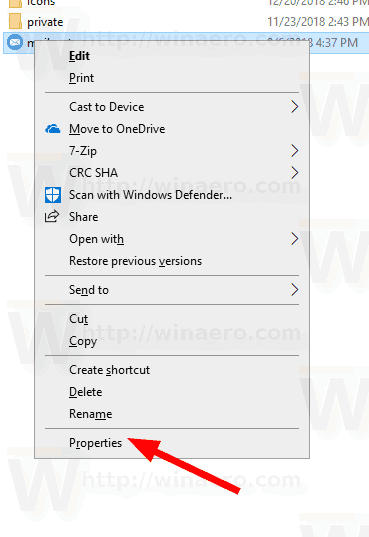
- Click on the Advanced button. The "Advanced Security Settings" window will appear.
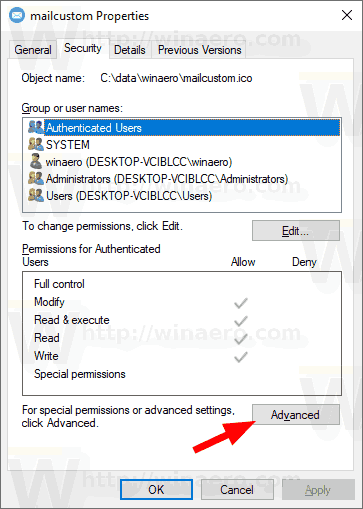
- Click on the Disable inheritance button.
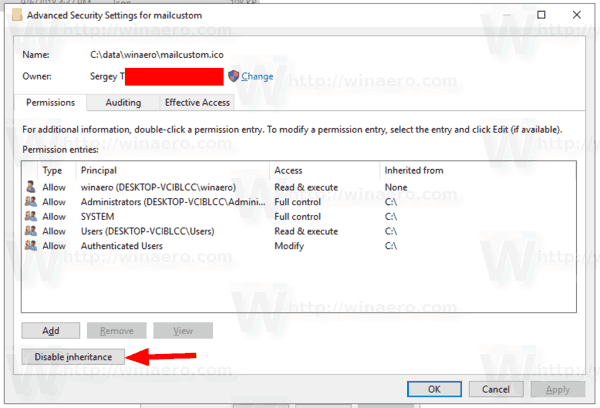
- You will be asked either to convert inherited permissions into explicit permissions or to remove all inherited permissions. If you are not sure, choose to convert them.
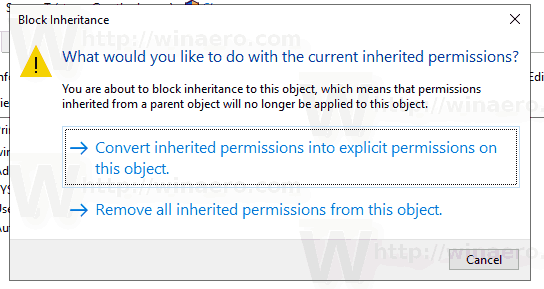
The following screenshot shows what happens when you choose to remove the inherited permissions. Only explicit permissions are left.
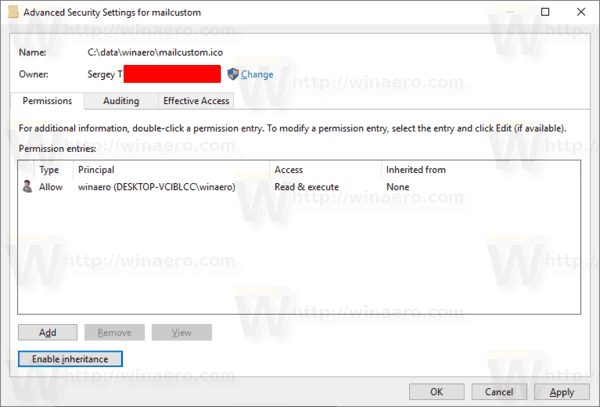
You are done. Click OK to close the dialog.
Enable Inherited Permissions for a File or Folder in Windows 10
- Open File Explorer.
- Locate the file or folder with disabled inherited NTFS permissions.
- Right-click the file or folder, click Properties, and then click the Security tab.
- Click on the Advanced button. The "Advanced Security Settings" window will appear.

- If you see the Change permissions button, click on it.
- Click on the button Enable inheritance.
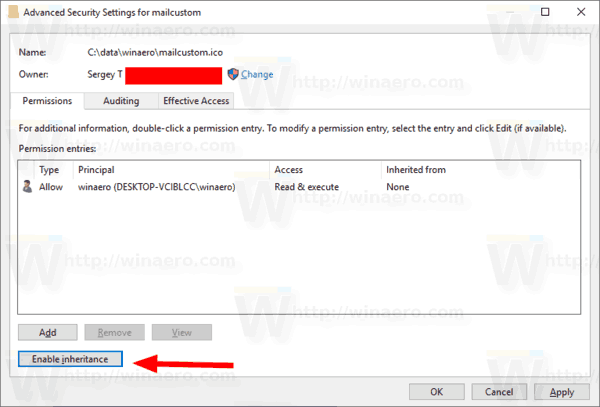
You are done. The inherited permissions will be added to the list of current permissions.
Note: If you are enabling or disabling permission for a folder, you can turn on the option Replace all child object permissions entries with inheritable permission entries from this object to update permissions for all child objects.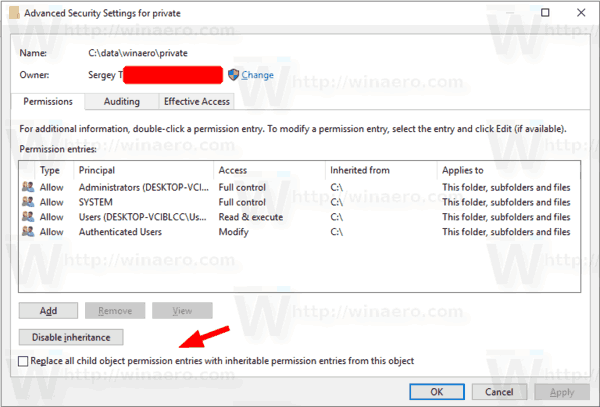
Enable or Disable Inherited Permissions for a Registry Key
Subkeys can have inherited permissions from their parent key. Or, subkeys can also have explicit permissions, separate from the parent key. In the first case, that is, if the permissions are inherited from the parent key, you have to disable inheritance and copy permissions to the current key.
To change the inherited permissions for a Registry key,
- Open the Registry Editor app.
- Go to a Registry key you want to disable or enable the inherited permissions. See how to go to a Registry key with one click.
- Right click on that key and select the Permissions... option from the context menu.
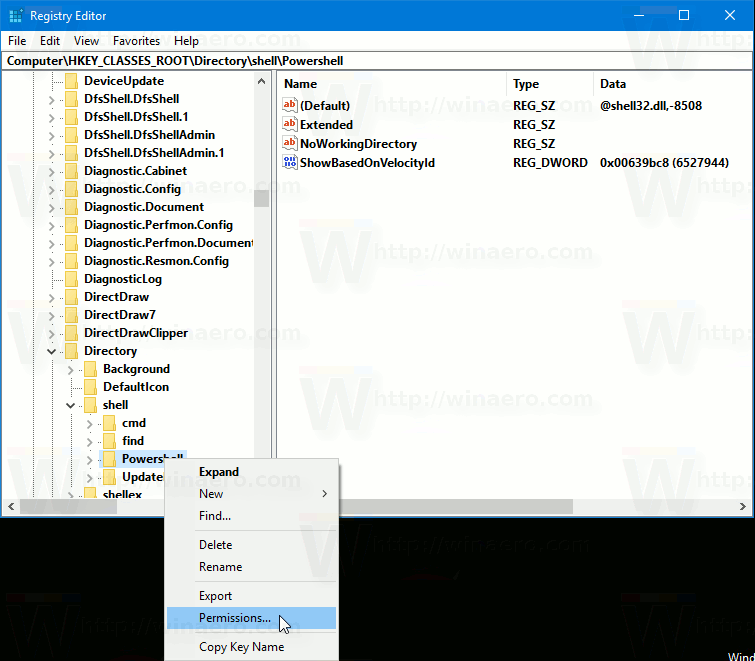
- In the next dialog, click on the Advanced button.
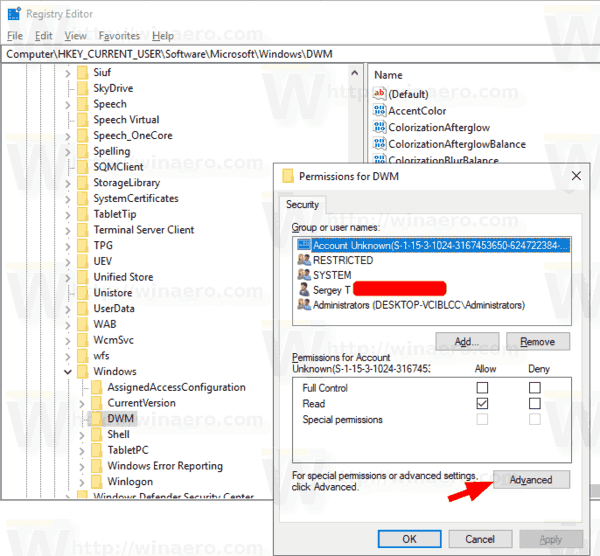
- Click on the button Disable inheritance to disable the inherited permissions.
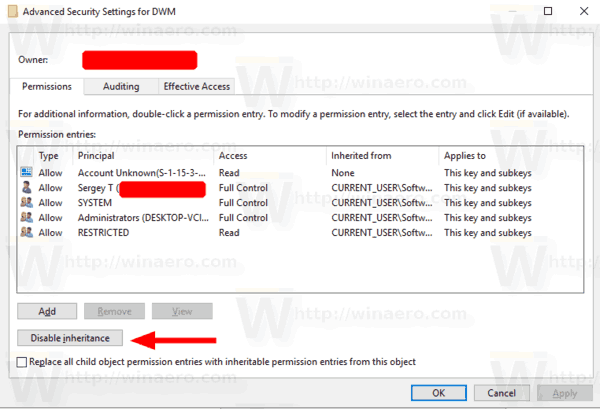
- Click on the button Enable inheritance to enable the inherited permissions for a key with disabled inherited permissions.
Also, see the following guide:
Windows Registry Editor for dummies
Enable or Disable Inherited Permissions in the Command Prompt
- Open an elevated command prompt.
- Run the following command to disable the inherited permissions for a file or folder and convert them into explicit permissions:
icacls "full path to your file" /inheritance:d. - Disable the inherited permissions for a file or folder and remove them:
icacls "full path to your file" /inheritance:r. - Enable the inherited permissions for a file or folder:
icacls "full path to the folder" /inheritance:e.
That's it.
Related articles:
- Add Take Ownership Context Menu in Windows 10
- Backup Permissions For Files and Folders in Windows 10
- Add View Permissions Context Menu in Windows 10
- Add View Owner Context Menu in Windows 10
- How to restore the TrustedInstaller ownership in Windows 10
- How to take ownership and get full access to files and folders in Windows 10
Support us
Winaero greatly relies on your support. You can help the site keep bringing you interesting and useful content and software by using these options:

How can I disable inheritance to a registry key or mark a registry key read-only through command line?
Can this be done via a saved registry key?
Thanks a lot!
Did you ever figure this our Rasha?
I am trying to disable inheritance on all folders, files and subfolders. I have tried the icacls, but I not found an example of how to do this. I am trying to do this myself. This is what I have so far, but it did not work. ICACLS C:\Program Files /grant[f] User: administrators /inheritance:d /setintegritylevel Level[H] [/T] [/C] [/L] [/Q] . Could you please help me out with this? Thanks..Pia
I had this issue with Adobe acrobat update service where armsvc.exe and adobeARM.exe somehow get reinstalled although I have disabled the process and the task in Windows 10.
So I changed both programs’ security settings in Properties and did a “disable inheritance”
N.B. first of all, I changed the owner from System to myself !
Now the disabled task cannot be changed to ready by Acrobat and it is not running !
Thanks a lot, guys.